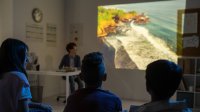Using Visual Thinking Strategies in the Classroom
An instructional technique developed in a museum can boost students’ critical thinking and evidence-based argumentation.
Your content has been saved!
Go to My Saved Content.You likely know the familiar challenge of keeping your students engaged during writing activities. My colleague Peggy Marconi, an elementary school teacher for 30+ years in rural communities in Oregon, has a love and passion for writing. Peggy especially loves argument writing because it teaches students evidence-based thinking: Students state their claim, provide evidence for that claim, and then summarize. In other words, argument writing asks students to think critically, using evidence. However, her students continued to struggle developing these writing skills, and she was seeking an effective strategy to guide them.
Many teachers also know that getting students to engage in art, to draw, or even to look at art is easier than getting them to write. Peggy saw how her students loved art, and when she learned about an instructional strategy taught in museums, she decided to combine her students’ interests in art with the need to learn evidence-based thinking and writing. She partnered with researchers at the University of Oregon, like me, and educators from the local museum, and Project STELLAR was launched, combining visual arts and writing using Visual Thinking Strategies in grades 4 to 8.
Phillip Yenawine of the Museum of Modern Art and Abigail Housen of Columbia University developed Visual Thinking Strategies (VTS) for teachers visiting the museum with their classes. Since it was created in 1991, teachers across the country—including rural Oregon—have witnessed the power of this strategy to elevate student discourse, critical thinking, and evidence-based argumentation.
VTS Session Overview
Here is a typical VTS session process: The teacher selects an appropriate piece of art or photograph and asks the students to spend a few moments looking at it before the discussion begins. After students silently examine the art, the teacher asks, “What’s going on in this picture?” The teacher calls on one student. As the student responds, the teacher points at the features of the image, if any, that the student mentions.
The teacher then asks the student the second question: “What do you see that makes you say that?” Again, the teacher points to the evidence in the image as the student speaks and then paraphrases.
The third and final question welcomes other student responses: “What more can we find?” When another student responds, the teacher continues to repeat the second and third questions, linking other student responses. It’s important to note that there are no right or wrong answers.
Tips for Using This Strategy in the Classroom
Select pictures that your students can connect with: As a stand-alone strategy, VTS has been used in all grade levels, from kindergarten to medical school residents. Project STELLAR incorporates writing, so our focus is on fourth through eighth grades. Regardless of student age, a good VTS lesson starts with selecting a developmentally appropriate picture. Picture selection can also connect to content area instruction, like a history or science lesson. Picture selection can also positively highlight the various cultures of your local community.
Include students with diverse needs: In a VTS session, there is no right or wrong answer. Students may be afraid to respond if they are a struggling learner or do not speak English as their first language; they should not have to worry if their answer will be accepted. All student answers are acceptable. Even a student who is blind or has a visual impairment can participate by listening to sighted students, and based on their descriptions, the student with the impairment can hypothesize what is happening in the picture. Keep the three questions simple so that instead the visual parts of the brain can focus on the picture.
Integrating argument writing: Keep the engaging vibe going by asking students to write what they said or what they heard during the session. You can display the three VTS questions as a guide. Ask students to first write what they think is going on in the picture. Ask for evidence why they think that, and then end with a summary statement about what is happening in the picture. Some students may change their description based on what other students contributed. In the end, we find that students always look forward to the next VTS session.
To learn more about VTS and Project STELLAR, here are some helpful resources:
- Permission to Wonder: The website of the creator of Visual Thinking Strategies.
- Jordan Schnitzer Museum of Art: Teachers can request a free account to access the permanent collection online.
- What’s Going On in This Picture?: The New York Times posts a picture each day for K–12 teachers to use in class.
- Project STELLAR: Check here for updates and free resources.
